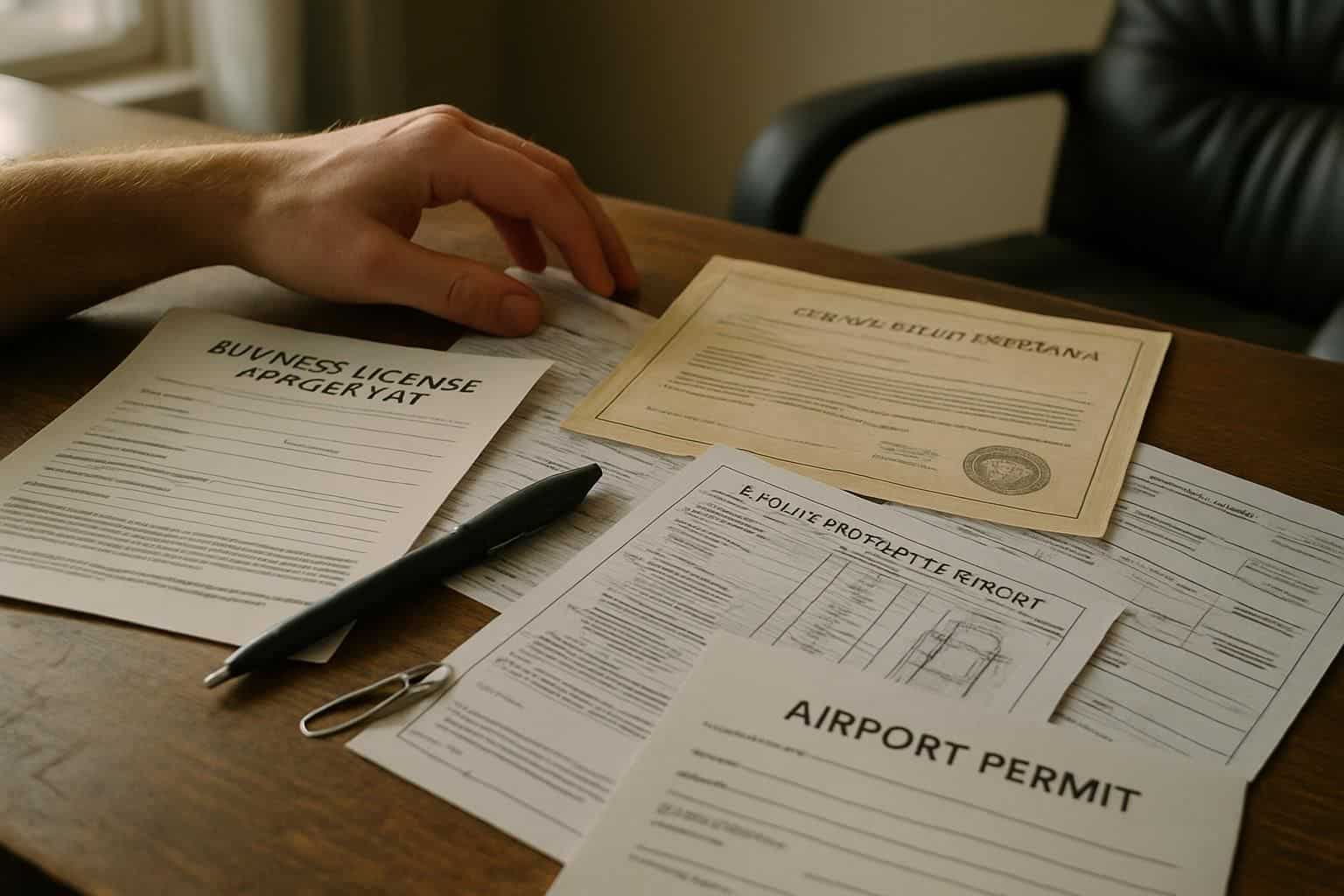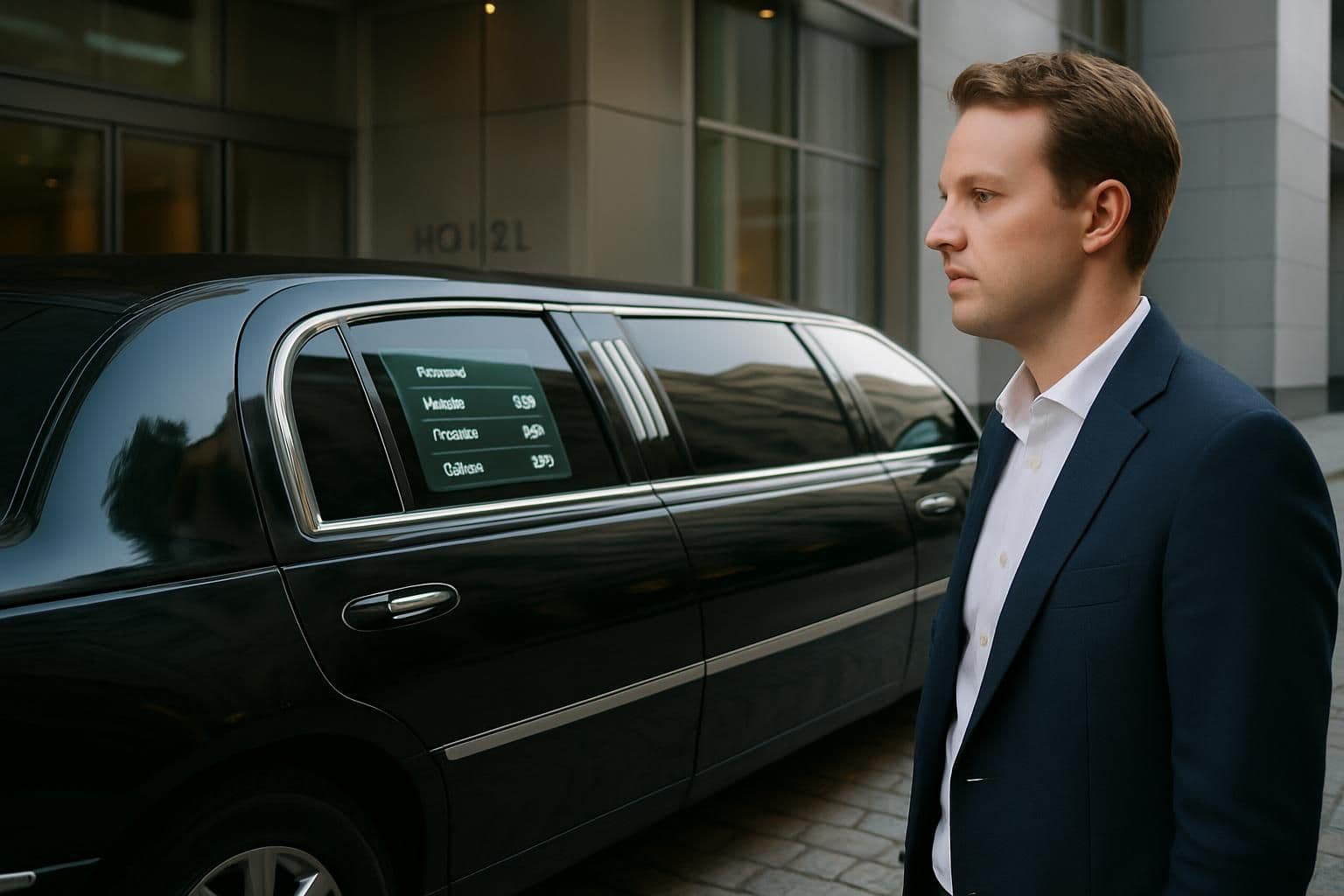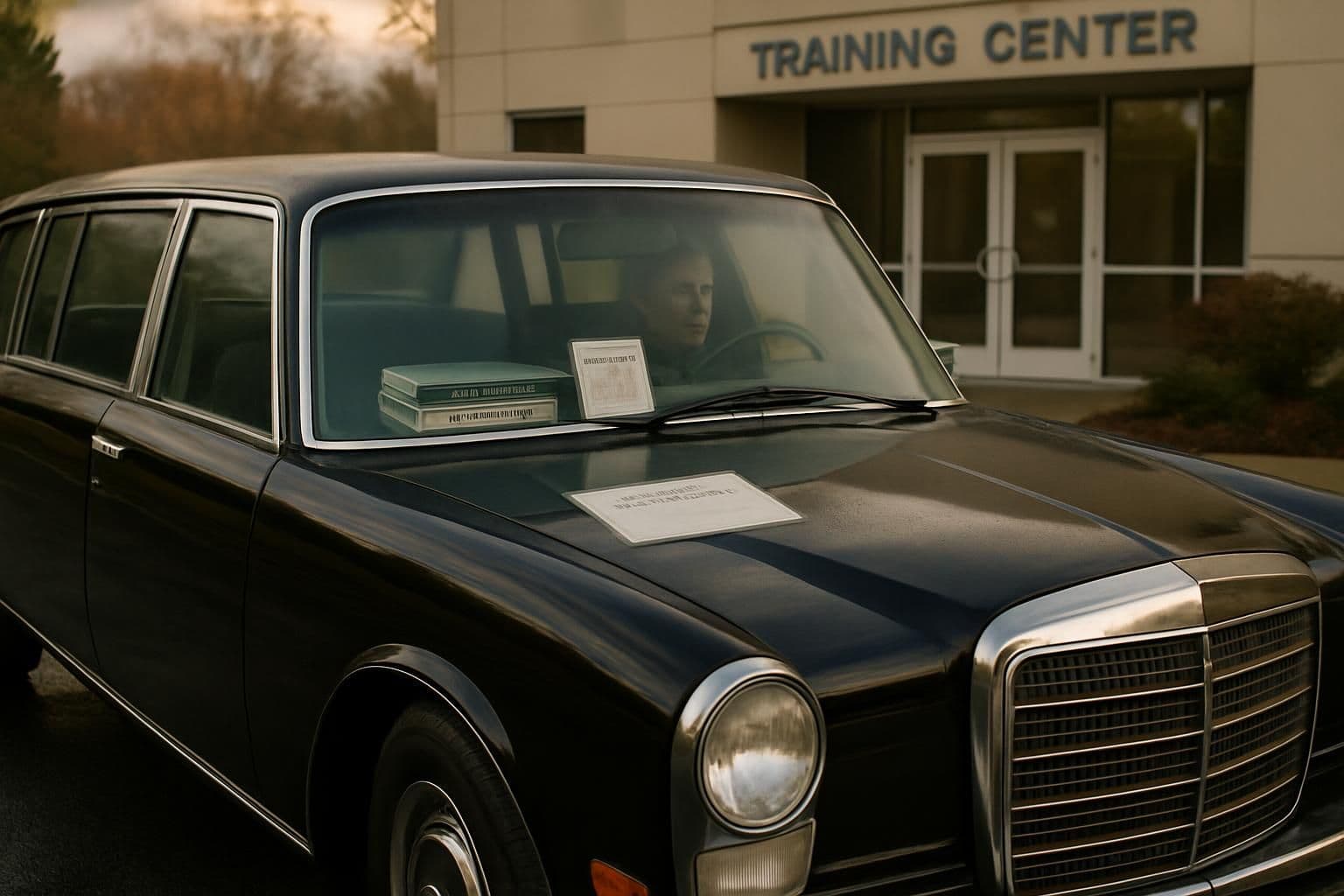Are you dreaming of how to start a limo business but unsure about the first steps? Starting a limousine business means getting special licenses and using approved vehicles like classic cars, stretch limousines, or executive vans.
This guide will show you clear steps from market research and fleet management to driver hiring and marketing strategies. Keep reading for easy tips to get your luxury transportation rolling in 2025!
Key Takeaways
Launching a limo business takes around $50,000 to $100,000 per vehicle—with ongoing monthly costs like $200-$500 in upkeep and $600-$1,200 for vehicle coverage.
Vehicle choices include SUVs, executive sedans, stretch limos, classic cars, vans, and party buses—each suitable for weddings, corporate events, prom nights, and special occasions.
Licensing essentials cover a standard business license, chauffeur endorsement, vehicle inspection paperwork, and insurance coverage of at least $1,050,000.
Industry profits average around 10-20%, depending heavily on pricing tactics such as peak-hour pricing, seasonal specials, and offering various service packages.
Drivers must be 21 or older, hold a valid state-issued license, pass background checks, and finish a defensive driving class lasting four hours.
Table of Contents
Analyzing the Limo Business Market

Know your rivals and market gaps before you start your limo company. Study local demand patterns to find the best spots for your luxury transport service.
Competitor Analysis

Understanding your competition helps your limo company thrive. Major ride-hailing rivals include Uber, Lyft, and Grab. You’ll need to identify both direct competitors—other limo services—and indirect ones, like taxi companies and app-based rideshares.
Put together a spreadsheet to monitor details such as pricing, vehicle choices, customer targets, and extra perks offered by each competitor. Spotting gaps they miss can give you the edge.
For instance, if local limo providers don’t include complimentary airport Wi-Fi, offering that could set you apart.
Finding ways to stand out is key in this busy market. Explore how rivals handle their customer service, from initial booking to final drop-off. Look at their social media pages, scan customer reviews, and uncover specific areas needing improvement.
Clearly state what makes your limo service unique in your business plan. Possible advantages could include highly skilled chauffeurs, exclusive luxury vehicles, or special event deals.
Your marketing approach should build upon these unique strengths. Next up, we’ll cover defining your services clearly within your business plan. To efficiently manage all this competitive data, try using Limo Software.
Target Audience Identification

Knowing exactly who your limo clients are can make or break your business. Teens usually look for stylish rides to prom, adults book elegant vehicles for weddings, and celebrities expect luxury transportation with privacy for events like award nights.
Your success hinges on carefully matching your service to each group’s preferences. I ran a small limo fleet a while back and noticed corporate customers cared most about being on time—every time.
Wedding bookings, though, mostly depended on how stunning the limousine looked.
The right customer at the right time equals profit in the limo business.
Solid market research becomes the backbone of your business strategy. Teens often prefer flashy amenities and perfect settings for Instagram photos. Corporate travelers typically insist on reliable Wi-Fi and cozy seats.
Celebrities usually prioritize privacy features, along with top-notch security. You can easily get this information by running social media surveys or local questionnaires. Your marketing should clearly talk to each client group on their favorite channels—Instagram works great for teenagers, while LinkedIn connects better with business professionals.
Creating Your Limo Service Business Plan

A solid business plan works as your roadmap to limo success. Your plan should spell out your services, costs, and how you’ll make money in the growing transport market.
Service Definition
Your limo service needs a clear identity to stand out from competitors. First, list each service clearly: airport pick-ups, wedding rides, corporate event transport, or sightseeing tours.
Include details like the type of car you’ll use, what drivers will wear, and extras such as complimentary snacks or free Wi-Fi. Luxury vehicles driven by professional chauffeurs—without meters—form the backbone of successful limo businesses.
Your offerings should match exactly what your customers want, while also fitting neatly into your startup budget.
Next, build attractive packages designed for different customer groups. Business clients usually care most about reliable timing and easy-to-use mobile booking apps; wedding couples often love extra touches like decorations, champagne, and flowers.
Be sure to price each package differently, carefully factoring in fuel expenses, vehicle insurance, and your drivers’ salaries. You can use digital marketing tools to easily track which packages catch the eye of your target customers.
Financial Projections and Budgeting
Solid financial planning is key to making your limo business thrive. A clear budget starts by carefully listing all startup expenses—which often run from $50,000 to $100,000 for just one limo.
These initial costs cover vehicle buying, permits, insurance, and early marketing. Monthly expenses matter too, including vehicle upkeep ($200–$500) and insurance ($600–$1,200).
It helps to use spreadsheets to closely monitor cash flow and set aside extra money for unexpected repairs or slower business cycles. Most limo businesses target profits of about 10–20%, but it usually takes some time to reach that goal.
Reliable revenue forecasts make banks and investors feel confident funding your business. Break down your expected revenue clearly by service type—airport rides, weddings, corporate events—and even by season.
Include slower periods in these projections and plan ahead for growth stages, like adding new cars to your fleet. Use credit cards carefully for business-related costs, but keep away from costly debts with high interest rates.
Many first-time limo owners underestimate expenses in their initial year—add an extra 15% cushion to your financial projections to stay safe.
The difference between a struggling limo service and a thriving one often comes down to financial discipline and accurate forecasting.
Acquiring Your Limo Fleet

Your fleet forms the backbone of your limo business, so choose vehicles that match your target market’s needs. You’ll need to decide between buying new cars for long-term value or leasing to reduce upfront costs while still offering luxury rides to clients.
Buying vs. Leasing Limousines
Limo fleet decisions shape your business future. Smart operators compare financial options before adding vehicles. Each approach offers distinct advantages for tech-savvy entrepreneurs.
| Factor | Buying Limousines | Leasing Limousines |
|---|---|---|
| Initial Capital Requirements | High upfront investment; typically requires 20-30% down payment | Lower initial costs; often just first month payment plus security deposit |
| Asset Ownership | Full ownership rights; vehicle becomes business asset | No ownership; must return vehicle at lease end |
| Monthly Cash Flow | Higher monthly payments but builds equity | Predictable monthly payments; often lower than loan payments |
| Customization Options | Complete freedom to modify vehicles with custom features | Limited modifications allowed; must return in near-original condition |
| Maintenance Responsibility | Owner bears all maintenance costs and risks | Reduced maintenance risks; some leases include maintenance packages |
| Tax Implications | Depreciation deductions; interest payment deductions | Entire lease payment may be tax-deductible as business expense |
| Fleet Upgrading | Must sell owned vehicles to upgrade; potential resale value loss | Easy transition to newer models at lease end |
| Long-term Cost | Generally lower total cost over 5+ years | Higher total cost for extended periods but lower short-term burden |
| Mileage Restrictions | No restrictions on vehicle usage | Strict mileage limits with excess charges (typically 10-15¢ per mile) |
| Exit Strategy | Must find buyer or trade-in; subject to market conditions | Simply return vehicle at lease end; option to purchase sometimes available |
Selecting Appropriate Limo Models
Selecting the ideal limousine models can truly shape your business success, affecting your profits, client experiences, and competitive edge. Consider these key limo options to boost your fleet:
- Executive Sedans provide luxurious comfort in a compact package. These cars need a wheelbase of at least 114.5 inches and an MSRP above $35,000, which makes them ideal for airport rides and corporate customers.
- SUV limousines offer more room without giving up style. They’re popular for weddings or proms, attracting small groups who need extra space but don’t need a stretch limo.
- Stretch limousines remain popular classics for special occasions. Their longer wheelbases let passengers celebrate comfortably inside, available in sizes ranging from 6-passenger to 14-passenger models.
- Executive Vans combine luxury with practical appeal. With space for 7-14 riders, they’re great for corporate events, group tours, and airport transportation.
- Classic Cars from over 30 years ago draw in specialty markets. Vintage models like Rolls-Royce or Bentley often command higher rates, especially for weddings and photo sessions.
- Party buses cater to guests craving lively entertainment. With sound systems, dynamic lighting, and onboard bars, they’re a hit for bachelor parties or nights out on the town.
- Specialty limousines can drive brand excitement and publicity. Men’s lifestyle blog Unfinished Man mentions how vehicles like the Batmobile Limousine attract superhero enthusiasts, allowing limo operators to charge premium prices.
- Eco-friendly luxury vehicles appeal strongly to environmentally aware customers. Electric car models, such as the Tesla Model S, draw corporate clients who prioritize sustainability.
- Vehicles equipped with accessibility features can help increase your potential audience. Limousines designed with wheelchair access help clients with specific mobility needs who often struggle to find suitable options.
- Building a diverse fleet helps reduce marketplace risks. In my experience, launching your limo fleet with 2-3 distinct vehicle categories lets you gauge customer interest clearly before committing large sums.
Securing Necessary Licenses and Permits

Starting your limo business means jumping through a few key hoops first. To hit the road legally, you’ll need certain licenses, permits, and paperwork sorted out right from the start.
- Get your Business License from the city or county government office, enabling legal transportation operations.
- Fill out a Limousine Carrier Chauffeur Addendum form, proving your drivers comply with local requirements.
- Obtain a Certificate of Insurance demonstrating at least $1,050,000 coverage, meeting mandatory standards for passenger transport.
- Arrange a Vehicle Inspection Report with either the Washington State Patrol or City of Seattle, certifying your vehicles pass necessary safety checks.
- Set up a P.O. Box address, required for receiving official mail and licensing paperwork.
- Obtain your Transportation Network Company license if your plans include offering rides through mobile apps.
- Secure airport permits, allowing your company to legally pick up or drop off customers at area airports.
- Get commercial auto insurance coverage that protects vehicles, drivers, and passengers throughout business activities.
- Obtain special commercial vehicle license plates through the state Department of Motor Vehicles.
- Contact your local Taxi and Limousine Commission office to verify any region-specific operating rules for your business.
Building Your Limo Business Marketing Strategy

A strong marketing plan will drive your limo business to success in a crowded market. Your strategy needs to focus on both digital channels and local promotion to reach clients who need luxury rides.
Establishing an Online Presence
Your limo service deserves a solid digital presence to connect with tech-savvy clients. First, create a mobile-ready website that clearly shows off your vehicles and services. Offer live booking options and transparent pricing plans to draw in your ideal customers.
Leverage social media sites such as Instagram and Facebook, highlighting stylish photos of satisfied riders and luxurious cars.
In the digital age, your online presence is often your first impression with potential customers.
Consider launching a custom mobile app built around three main features: an admin dashboard to handle daily business tasks, a driver section for managing routes and schedules, and a customer-facing area for seamless bookings.
Add live GPS tracking, giving clients peace of mind about their vehicle’s exact arrival time. Secure online payment options through debit cards provide smooth and convenient transactions.
Finally, invest in solid search engine optimization strategies, helping local users easily discover your limo business online.
Engaging in Local Advertising
Having a solid digital presence is beneficial, but local advertising puts your limo business directly in front of nearby customers. Print advertisements in local magazines or newspapers still catch people’s interest around your neighborhood.
Eye-catching billboards placed along busy routes can grab attention from thousands of daily drivers—some of whom might soon need limo services for weddings, proms, or special gatherings.
Local radio commercials are another effective choice, reaching commuters already spending plenty of time in cars each day. Forming partnerships with hotels, travel agencies, or event planners, offering special discounts or referral codes, helps attract new clients smoothly.
Sponsoring community events, like sports matches, festivals, or local fairs, boosts brand visibility while showing genuine support for your area. These focused marketing strategies usually cost far less than large-scale advertising campaigns—but often deliver stronger results for limo startups aiming to expand locally.
Setting Limo Service Pricing and Packages
 Smart pricing sets your limo business up for success—covering costs, bringing in customers, and keeping you ahead of competitors. Here’s how to price effectively:
Smart pricing sets your limo business up for success—covering costs, bringing in customers, and keeping you ahead of competitors. Here’s how to price effectively:
- Add up your monthly expenses like vehicle payments, insurance costs, fuel, and regular maintenance; divide this total by anticipated service hours, giving you your base hourly rate.
- Check out local competitors’ pricing through anonymous calls and by browsing their websites—this helps you set rates that attract the right clients without underselling your services.
- Offer pricing tiers with clear names like “Basic Transportation”, “Corporate Executive”, or “Luxury VIP Service”—each appeals to a different type of customer.
- Aim for profit margins of 10% to 20% per service; this ensures your limo business grows steadily while staying affordable in a competitive ride-service market.
- Plan fixed-price event packages—weddings, proms, corporate gatherings—clearly noting what’s included such as driver tips and any special extras like refreshments or decor.
- Set up seasonal deals like “Winter Wedding Deals” or a “Summer Event Shuttle” to fill your limo schedule during slow months.
- Introduce higher rates during busy times—New Year’s Eve, local festivals, or prom weekends—to capture maximum revenue from peak demand.
- Create rewards programs and referral incentives to thank regular riders and to encourage your happy clients to spread the word.
- Partner with local businesses like wedding venues, hotels, or event coordinators; combine services into joint packages, drawing in new customers and added bookings.
- Check your pricing every three months; make changes based on actual costs, customer suggestions, and local market trends.
Up next, we’ll cover ways to hire great drivers and train them to impress your customers on every ride.
Hiring and Training Your Drivers

Your drivers represent your limo business—they shape your customers’ first impressions. Finding and preparing suitable drivers takes planning, clear expectations, and thoughtful training.
Here’s a straightforward checklist to help you hire and train effectively:
- Define clear hiring standards, like a minimum age limit of 21 years and a valid Washington State Driver License, to meet state requirements.
- Draft a clear and detailed job description that includes tasks, work hours, wage details, and benefits—this helps attract the right candidates.
- Conduct complete background checks through the Washington State Patrol on all potential hires to protect your passengers.
- Check applicants’ driving records for the previous five years—this process can highlight any potential red flags or risky driving habits.
- Make sure each new hire completes a 4-hour defensive driving course provided by the National Safety Council.
- Carry out mandatory drug screening during the hiring process and perform random checks throughout their employment.
- Create a clear, easy-to-follow training guide that details company rules, vehicle care, routes, and customer interactions.
- Teach your drivers to comfortably use the mobile apps your company depends on, like navigation tools and booking systems.
- Provide training in professional customer interaction—including welcoming passengers warmly, handling luggage appropriately, and communicating clearly.
- Offer attractive pay along with incentives or bonuses for top-notch performance—this can boost driver motivation and keep great staff longer.
- Set neat, professional dress guidelines that clearly reflect your company’s image and values.
- Introduce a referral bonus program to encourage your current drivers to recommend qualified new applicants.
- Schedule regular short training updates to sharpen drivers’ skills and address any customer service challenges.
- Arrange mentorship pairings, matching new hires with experienced drivers for their first few weeks on the job.
Enhancing Limo Customer Experience

Outstanding customer service is the foundation behind every thriving limo business. Equip your drivers and dispatchers with clear guidelines to ensure courteous, professional, and efficient service.
Drivers should know the city’s roads perfectly, keeping vehicles spotless every single ride. Dispatchers need the skills to handle reservations quickly through a user-friendly mobile app or reliable phone support system.
This relentless dedication to excellent service generates strong word-of-mouth marketing—free of charge and highly effective.
Customer reviews form the backbone for improving your limo service daily. Create an easy-to-use system for gathering feedback right after every ride, and reply promptly—whether it’s a glowing compliment or a serious complaint.
Small details make big impacts, like offering bottled water, free Wi-Fi, or phone charging cables; these thoughtful extras often set you apart from rivals. Many business owners overlook such simple gestures, but they help clients feel appreciated, boosting referrals organically.
Repeat customers keep the limo industry successful, so each satisfying ride strengthens your company’s reputation and encourages future growth.
Launching and Promoting Your Limo Business

You’ve nailed your limo customer experience, now it’s time for a successful launch. Make your opening event unforgettable, attract your first batch of clients, and start your momentum strong.
- Organize a grand opening celebration, letting local business owners personally sample your limo services—perfect chance to connect with potential clients, face-to-face.
- Set up social media profiles on platforms your ideal customers prefer, posting high-quality images of your vehicles, along with exclusive opening-day deals.
- Form partnerships with nearby hotels, wedding planners, and event spaces—they’ll send clients your way, and you can offer them commissions or cross-promotional benefits.
- Offer discounted launch deals or special introductory packages—perfect for turning curious first-timers into loyal regulars.
- Start a referral program—happy customers get discounts each time they recommend someone new to your service.
- Concentrate your marketing on local networking events and building steady community partnerships—making sure neighborhood folks know (and like) your brand.
- Launch an easy-to-use mobile app—letting customers effortlessly book a limo from their phones.
- Invest in professional photos of your vehicles for consistent, eye-catching marketing on websites, ads, and social media.
- Register a PO box specifically for business mail—keeps things organized, private, and professional.
- Cut your operational costs by nearly 30%—use simple AI tools to automate routine jobs like confirmations and booking reminders.
- Plan to grow organically—add about one new limo per year, responding directly to real demand, not just hopeful estimates.
- Craft social media marketing campaigns focused sharply on what makes your limo experience different (and better) than typical rideshare options.
How Will the Limo Business Evolve in 2025?

The limo business will change significantly by 2025, mostly due to new technologies. Luxury travel providers and smart ride-hailing apps will blend into combined business models. To stay competitive, limo companies must create user-friendly mobile apps for easy bookings and route mapping.
These apps will guide drivers to efficient routes, while customers can track their journeys live. Soon, market divisions will emerge—ultra-premium rides on one side, practical executive transfers on the other.
Even minivans will share garage space with classic stretch limos.
Investing in focused advertising will become a necessity as competition heats up. Successful limo business owners will zero in on precise customer groups rather than broad audiences.
Referral programs are likely to bring in more customers too—especially in big cities like New York, where the NYC Taxi and Limousine Commission (TLC) defines industry rules. Chauffeurs will have to master more than defensive driving; they’ll need additional tech training for modern vehicle features as well.
The most successful limo brands will combine premium service, smart tech solutions, and fair pricing to stay ahead in this changing market.
People Also Ask
How much money should I put aside to kick off a limo business in 2025?
Starting your limo service involves some careful budget planning. You’ll likely need between $50,000 and $150,000 to begin, with exact costs depending on your market choice and fleet size. That amount covers buying vehicles, securing licenses and insurance, and setting up a simple mobile booking app.
What steps help me identify my ideal customers?
Start by checking your local area for gaps or underserved markets in taxi or ride-hailing services. Next, pick a niche—maybe business travelers, wedding groups, or airport runs. Create branding and marketing materials that speak directly to these potential customers.
Does route planning matter much for my new limo business?
Route planning makes a huge difference—it saves both time and money. Smart routes mean fewer miles driven, less fuel burned, and more customers served each day. Many profitable limo services rely on mapping software to find the best, quickest paths.
Is accepting money orders an option for limo services?
Money orders can make sense, especially if some customers prefer not using credit cards. But most thriving limo businesses in 2025 will rely heavily on digital payments and mobile app transactions. Offering different payment choices attracts more varied clients, helping your business grow.
References
https://upmetrics.co/template/limousine-business-plan
https://bizsugar.com/startup-advice/how-to-start-a-limo-business/
https://www.elluminatiinc.com/how-to-start-limo-business-online/
https://smallbiztrends.com/how-to-start-a-limo-business/ (2025-02-21)
https://www.bplans.com/limousine-taxi-business-plan/
https://supposeudrive.com/the-business-case-for-leasing-vs-buying-commercial-trucks-in-2025/ (2025-04-15)
https://optimoroute.com/limo-business-tips/
https://truicbusinessideas.com/limousine
https://www.grepixit.com/blog/launching-an-online-limo-business-a-comprehensive-guide.html
https://www.moovsapp.com/post/how-to-grow-your-limo-business
